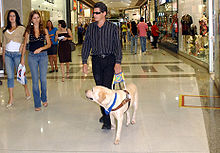Blindness
![]()
Blind is a redirect to this article. For other meanings, see Blind (disambiguation).
![]()
This article or paragraph presents the situation in Germany. Help describe the situation in other countries.
Blindness is the most pronounced form of visual impairment with a complete lack of visual perception in one or both eyes, or with very little visual perception in either eye. It can be congenital (birth blindness) or acquired. The chances of improvement or even cure are low, depending on the onset of the disease, its causes and - especially in "Third World" countries - generally the access to appropriate treatment services. Apart from this, there are a number of diseases for which there is no effective therapeutic approach and which are therefore considered incurable. If blindness affects both eyes, it is a severe disability for which, according to German legislation, there is in principle an entitlement to aid in the form of blindness allowance. It is regulated in the respective state blindness allowance law or as blindness assistance in the Social Code (SGB XII § 72).

Blind man with his guide dog
Definitions
| Degree of disability | Visual test on the better eye |
| blind | |
| Visual acuity not exceeding 0,02 or tubular visual field not | |
| severely visually impaired | Visual acuity between 0.02 and 0.05 |
| visually impaired | Visual acuity between 0,05 and 0,3 |
In Germany, according to legal regulations and care guidelines, a person is considered blind if his or her visual acuity in the better eye, even with optimal spectacle or contact lens correction, is at most 1/50 = 0.02 (somewhat misleadingly referred to as "2% or less"), or if there are other permanent visual impairments that are equivalent to this impairment. According to the German Ophthalmological Society (DOG), this applies, for example, to the concentric restriction of the outer visual field limits to a maximum of 5 degrees (tube visual field). Blindness in this sense does not include colour blindness (achromatopsia) and night blindness (hemeralopia).
To illustrate: a visual acuity (Visus) of 1/50 = 0.02, which is the limit to blindness with entitlement to blindness benefit, means that the just readable visual characters have 50 times the reference size of 5 visual angle minutes. This is 4.17 visual angle degrees, which corresponds to a font size of 2.2 cm at a reading distance of 30 cm.
A reduction in visual acuity to less than 0.3 in the better eye is called visual impairment. A person with a visual acuity of no more than 1/20 = 0.05 in the better eye with optimal correction is considered to be severely visually impaired.
The definition of blindness or visual impairment in the legal sense is always made with reference to the "person" concerned and not to the eye as an "organ". Visual impairment, severe visual impairment and blindness, on the other hand, can also occur unilaterally - with the normal visual capacity of the healthy eye - with the respective threshold values stated. From a medical point of view, this leads to a one-eyed (monocular) visual impairment or blindness, but the person concerned is not considered blind or visually impaired in the legal sense, so that in this case, assuming sufficient orientation ability, there is also no entitlement to pension benefits despite practical one-eyedness.
Amaurosis
In contrast to the term "blindness", the medical term amaurosis refers exclusively to the complete lack of light perception of one or both eyes with loss of all optical stimulus processing (complete blindness).
Questions and Answers
Q: What is blindness?
A: Blindness is the condition of not being able to see anything.
Q: Can people be called blind even if they can see a little bit?
A: Yes, some people are called blind even if they can see a little bit, because they cannot see clearly and only see unfocused shapes or colors.
Q: What mostly causes blindness in the world?
A: In all the world, blindness is mostly caused by malnutrition and diseases of old people, like cataracts and trachoma.
Q: Who can become blind?
A: People can become blind because of diseases or accidents, and some are born blind.
Q: What is legal blindness?
A: Legal blindness is defined as a level of visual acuity low enough to qualify for disability benefits and/or special accommodations. It is also defined as being unable to be completely corrected by prescription glasses or contact lenses.
Q: What is color blindness?
A: Color blindness is the inability to differentiate certain colors, where people can see but cannot tell certain colors apart.
Q: What do blind people use to do everyday things?
A: When people are blind, they use such things as the alphabet in braille and guide dogs to do everyday things.
Q: Who are some famous blind people?
A: Some famous blind people have included Louis Braille, the inventor of the braille alphabet, Stevie Wonder, Ray Charles and Helen Keller.
Search within the encyclopedia